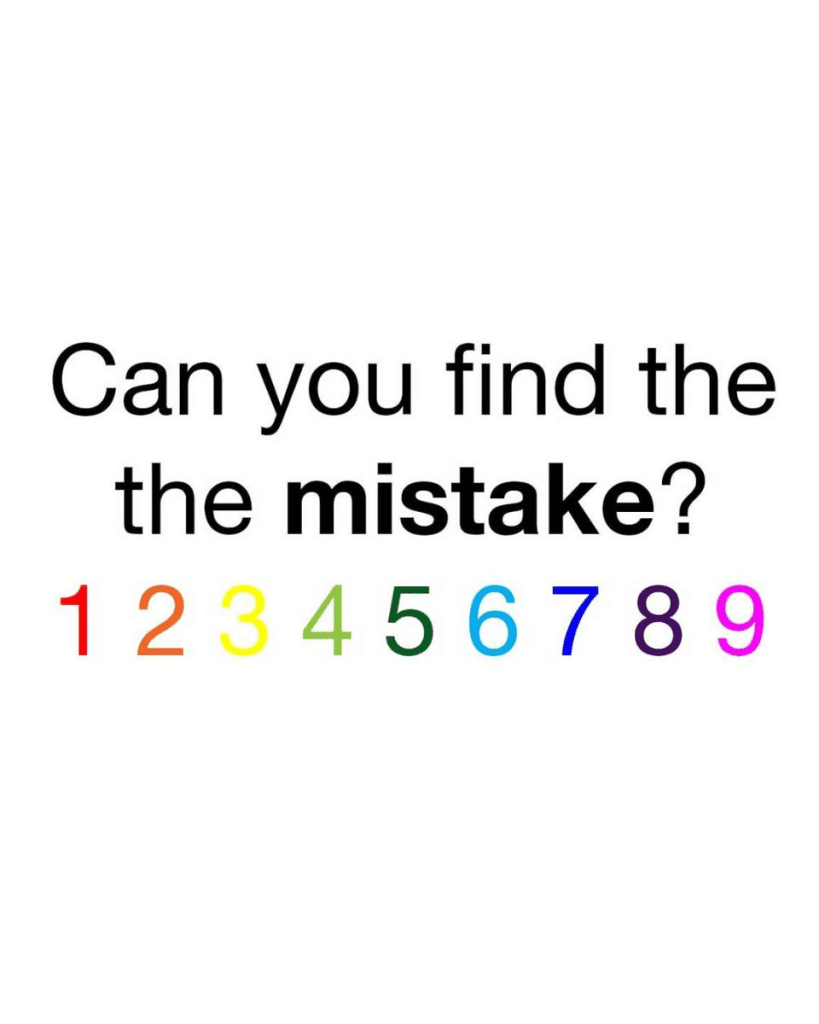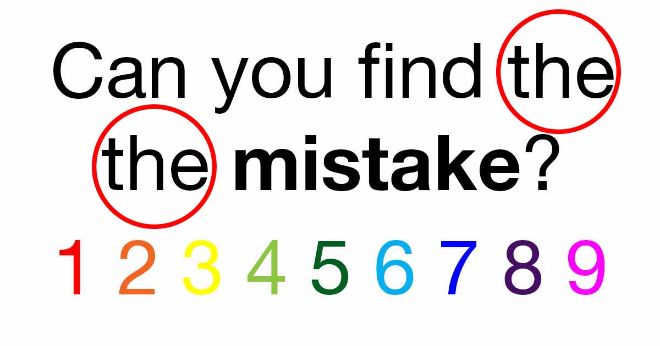At first glance, it seems simple—a colorful visual puzzle with a question, “Can you find the the mistake?” But if you’re like most people, your eyes are drawn to the vibrant numbers below or the words themselves, while the answer is cleverly hidden in plain sight. It’s a playful challenge that puts your focus and attention to detail to the test. So, what’s the mistake?

Look closely. The word “the” appears twice in the sentence, yet our brains often overlook this redundancy. This puzzle isn’t just a trick; it reveals fascinating insights about how our minds process information.
Let’s dive into why this happens and how puzzles like this sharpen our cognitive skills.

Why Do We Miss the Mistake?
Ever wonder why something so obvious can slip by unnoticed? The answer lies in how our brains interpret written information. When we read, our brains process words in chunks rather than letter by letter. This is why you can read a sentence with jumbled letters as long as the first and last letters are in the correct places.
In this case, the repeated word “the” doesn’t fit the overall context of the sentence, so your brain assumes it’s a typo and skips over it. Instead of focusing on each individual word, you read the sentence as a whole, prioritizing meaning over precision.
The Role of Cognitive Bias
This phenomenon ties into a concept called cognitive bias—our tendency to make decisions or judgments based on mental shortcuts. Here, your brain prioritizes efficiency, assuming the sentence is grammatically correct rather than closely analyzing each word.
It’s a brilliant example of how perception isn’t always reality. While your eyes technically see the repeated “the,” your brain decides it’s unnecessary to process it.
The Importance of Attention to Detail
Puzzles like this highlight the importance of slowing down and paying attention to detail. In a world where multitasking is the norm, our ability to focus deeply is often compromised. Small errors, like the repeated “the,” can easily go unnoticed when we’re rushing or distracted.
By challenging ourselves with exercises like this, we can train our brains to be more observant, improving both our critical thinking skills and our ability to catch mistakes.
How Puzzles Like This Benefit the Brain
Engaging with visual puzzles and word challenges isn’t just entertaining—it’s also good for your brain. These activities:
- Enhance focus and concentration: They force you to slow down and examine details you might otherwise miss.
- Boost problem-solving skills: By identifying patterns and anomalies, you sharpen your ability to approach problems creatively.
- Improve memory: Regularly working on puzzles can strengthen your short-term and long-term memory.
- Encourage mindfulness: Taking a moment to focus solely on a puzzle promotes relaxation and reduces stress.
The Psychology of Hidden Mistakes
What makes puzzles like this so compelling? It’s all about the satisfaction of discovery. Finding the mistake, no matter how small, triggers a release of dopamine—the “feel-good” chemical in your brain. This sense of achievement keeps you coming back for more.
Additionally, hidden mistakes challenge your preconceived notions. You expect the sentence to be error-free, so spotting the repeated “the” feels like uncovering a hidden treasure.
Applying This Skill in Everyday Life
The ability to spot mistakes isn’t just useful for puzzles—it’s a valuable skill in daily life. Whether you’re proofreading a document, analyzing data, or even navigating conversations, attention to detail can make all the difference.
In the workplace, for example, catching errors can prevent costly mistakes, while in personal interactions, attentiveness shows you care. Exercises like this puzzle are a fun and effective way to hone these skills.
Why We Love a Good Challenge
Puzzles like “Can you find the the mistake?” are more than just brain teasers—they tap into our innate love of challenges. Humans are naturally curious creatures, and we thrive on problem-solving. Whether it’s piecing together a jigsaw puzzle or identifying a hidden error, these activities engage our brains in ways that feel rewarding.
And let’s face it—there’s something delightfully satisfying about cracking a puzzle that initially stumps us. It’s like solving a small mystery, and the “aha!” moment is its own reward.
Conclusion: The Fun of Finding the Mistake
So, did you spot the mistake right away, or did it take a second look? Either way, puzzles like this remind us of the quirks of our perception and the power of paying attention to detail. The repeated “the” may seem like a small oversight, but uncovering it reveals big insights into how our minds work.
Next time you come across a challenge like this, take a moment to slow down and really look. You might be surprised at what you discover—not just in the puzzle but in yourself. After all, life is full of hidden gems waiting to be uncovered, if only we take the time to see them.